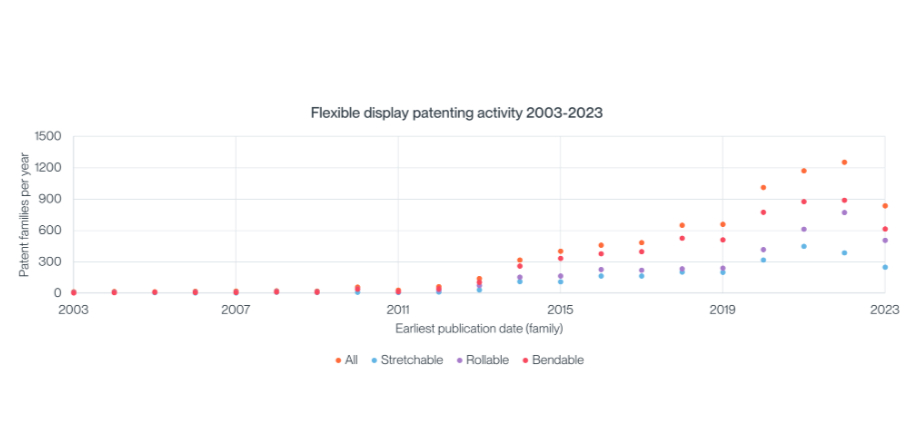As seen from the various products showcased at the CES and MWC, the form factors of consumer electronic devices are constantly evolving to meet the increasing demands on this technology sector. For instance, the ubiquitousness of these devices in multiple aspects of everyday life - from curved smart devices around a home or business to wearable electronics - has seen a shift away from traditional rigid and planar form factors.
One aspect of this evolution is reflected in the development of flexible displays, the market for which (according to one forecast on flexible OLEDs) has been estimated at USD 16.85 billion in 2023, USD 23.07 billion in 2024, and USD 162.26 billion by 2030.
HOW HAS PATENT ACTIVITY FOR FLEXIBLE DISPLAYS CHANGED IN RECENT YEARS?
Figure 1 shows that, except for 2023 (which may be an outlier year), patent activity1 has grown considerably since 2003.

Figure 1
The most prolific filers in each category - stretchable displays, rollable displays, and bendable displays - are Samsung (Electronics Co. Ltd. and Display Co. Ltd.), LG (Electronics Inc. and Display Co. Ltd.) and BOE Technology Group Co. Ltd. The top five countries / filing routes (for all the filings considered here) are the US (5666 documents over the 2003-2023 period), China (4258 documents), Korea (3949 documents), the PCT (2947 documents), and Europe (2148 documents).
WHAT ARE RECENT RESEARCH DEVELOPMENTS RELEVANT TO FLEXIBLE DISPLAYS?
These include:
In a paper published in the journal Nature, researchers from Stanford University report "high-density, intrinsically stretchable transistors and integrated circuits with high driving ability, high operation speed and large-scale integration". According to the paper and a corresponding press release, these advances are enabled by a combination of innovations in materials (semiconducting carbon nanotubes and soft elastic electronic materials), fabrication process design, device engineering and circuit design. A prototype LED display exhibited "a high refreshing speed of 60 Hz", comparable to the refresh rate of a conventional TV or computer display, and "excellent mechanical robustness".
In the journal npj Flexible Electronics, a team of Korean researchers have reported on their "Highly reliable and stretchable OLEDs [SOLEDs] based on facile patterning method: toward stretchable organic optoelectronic devices". Nonselective patterning using laser cutting is employed in this work to simplify the SOLED fabrication procedure, and a 3 × 3 array SOLED display module mounted on a stress-relief pillar platform is demonstrated that marks (according to the researchers) "the first case of water-resistant display array operation in the field of SOLEDs".
On the materials front, in Nature Materials a multi-disciplinary UK-based team have reported on a molecular design where ultranarrowband blue emitters are covalently encapsulated by insulating alkylene straps, which substantially reduces Dexter transfer (a fluorescence quenching mechanism) and opens the door to "highly efficient 'matrix-free' blue hyperfluorescence".
WHERE MIGHT PATENT PROTECTION LIE IN FLEXIBLE DISPLAYS INNOVATION?
As with any display technology, ongoing challenges include performance, efficiency, durability / stability, and sustainability. As such, and with reference to the example research developments summarised above, flexible displays innovation (and thus potential patent protection) may lie in improved materials, device architectures, and/or methods of manufacture, operation, or recycling.
The potential contribution of software-based inventions to flexible displays should not be overlooked either, particularly where machine learning is used for materials discovery.
The future of flexible displays, given the forecast market growth within this decade, therefore appears bright.
To find out more about how intellectual property can help you create commercial value from your innovation, please feel free to contact us.
Footnote
1 The data in this article is from a search of Espacenet for patent families that are classified under G06F1/1652 the display being flexible, e.g. mimicking a sheet of paper, or rollable. The data subsets reflect wildcard searches (e.g., "roll*") within the G06F1/1652 classification.
The content of this article is intended to provide a general guide to the subject matter. Specialist advice should be sought about your specific circumstances.



